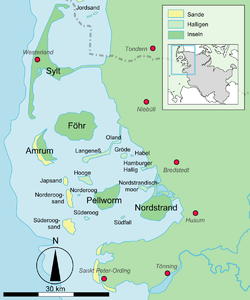South fall
| South fall | ||
|---|---|---|
| Waters | German Bight , North Sea | |
| Archipelago | North Frisian Islands | |
| Geographical location | 54 ° 27 '55 " N , 8 ° 43' 35" E | |
|
|
||
| length | 1.2 km | |
| width | 620 m | |
| surface | 56 ha | |
| Highest elevation | (Terp) 3 m |
|
| Residents | 2 3.6 inhabitants / km² |
|
| main place | South fall | |
| The islands and halligen in the North Frisian Wadden Sea | ||
Südfall ( Danish : Sydfald ) is a Hallig in the Wadden Sea on the North Sea coast in the west of Schleswig-Holstein . It has a size of 0.56 km² and administratively belongs to the municipality and district Pellworm . The Hallig is leased and is inhabited by two people from March to November.
history
Before the 1st Groten Mandränke in 1362, the area of today's Hallig belonged to the Edomsharde in what was then the Strand landscape . This flood created the Halligen Südfall, Nübell (or Nubel ) and Nielandt . In 1633 Südfall was measured because it was planned to include the Halligen in the damming of the Norderhever . At that time, Südfall was about 4 km long and 600 hectares in size. The Burchardi flood in 1634, which destroyed Strand, also destroyed these plans and greatly reduced the size of the Hallig. Nübell went down in the flood, but Südfall remained inhabited. Now that Südfall had become smaller and smaller, the residents moved to Nielandt and named it Südfall. The inhabitants lived from agriculture, fishing, salt peat mining and the occasional beach robbery .
On February 3 and 4, 1825, almost the entire population of twelve families was wiped out in the so-called Hallig flood . The three terps in the west sank and the area of the Hallig was reduced by half. The present terp was built in 1828. In the following years the Hallig changed hands several times.
In 1910, Countess Diana von Reventlow-Criminil († 1953) acquired the island to spend her old age there. After that, a 50-year lease ran under the Dethleffsen family. In 1921, the Nordstrander Andreas Busch discovered the remains of lock systems near Südfall in the Watt. He mapped the area and found many traces of culture such as wells, fields, paths and ditches. Based on these findings, it is assumed that Rungholt was located on the site of Südfall from the 13th to the 14th century. Since 1960, the average number of floods per year has risen from around 30 to around 70.
present
Today Südfall belongs to the state of Schleswig-Holstein and has been looked after by the Jordsand association since 1957 . The Hallig has been a nature reserve since 1959 and is now part of the Schleswig-Holstein Wadden Sea National Park . On the only terp in the west of the Hallig there is a residential building with ancillary buildings in which a bird protection station and the SAR watch / radio station of the DGzRS Südfall are housed.
The management is carried out by a water manager and his wife.
traffic
Südfall can be reached from Nordstrand on foot or by horse-drawn carriage as part of the guided tours across the mudflats approved by the National Park Office . In summer the Hallig can be reached by ship from Pellworm up to three times a week. Since Südfall is in protection zone 1 of the Schleswig-Holstein Wadden Sea National Park, entering the Hallig is otherwise not permitted.
nature
The Hallig has a main stream that starts in the west and ends in a wide estuary in the east. The Hallig salt marshes are only partially grazed. Therefore there are large deposits of salt plants such as beach carnation , beach mugwort , beach lavender and beach aster . Many species of birds use the Hallig for breeding. To be emphasized here are z. B. the spoonbills , little terns and jacketed gulls .
The mudflat around Südfall is an excavation reserve to prevent the destruction of traces of culture.
Shrimp boat near Südfall
Web links
- Südfall and Rungholt
- Südfall, looked after by the Jordsand association
- Mudflat hike to the Hallig Südfall
- NDR documentary about Südfall
- Südfall and the Halliggräfin
Individual evidence
- ↑ Dirk Meier, Hans Joachim Kühn, Guus J. Borger: The coastal atlas. The Schleswig-Holstein Wadden Sea in the past and present . Boyens, Heide 2013, p. 134
- ^ Südfall and Rungholt , accessed on November 22, 2010





